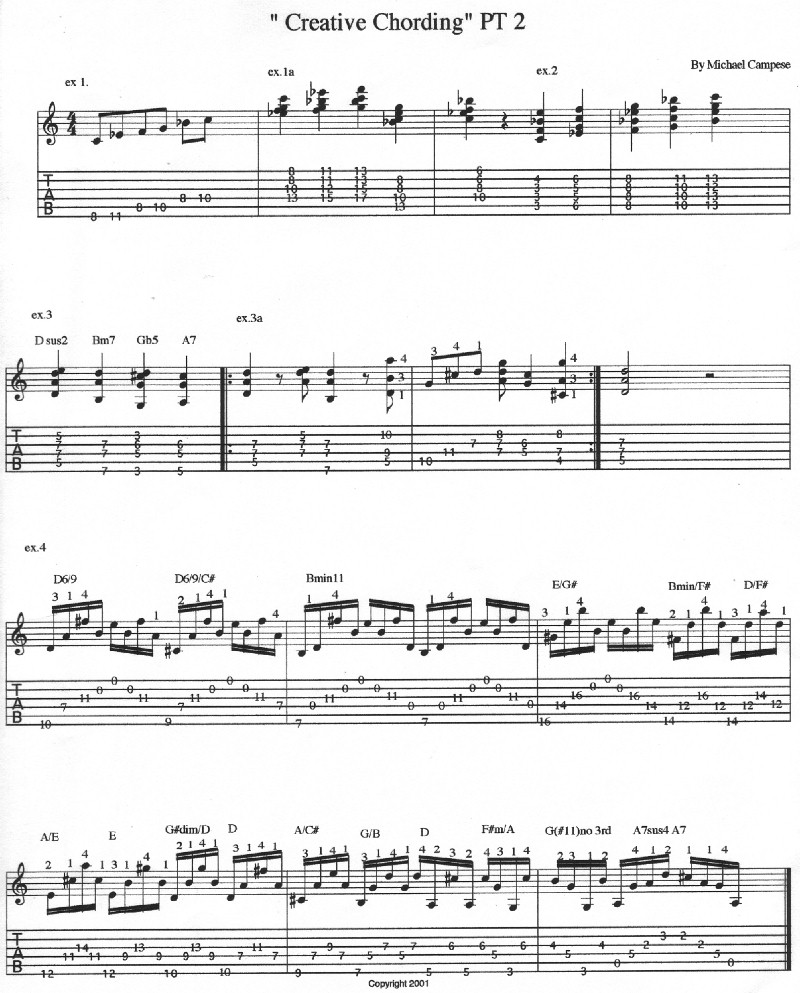Hello everyone! It's great to be back again. Thanks for checking out the lessons. Today we are going to talk about more creative ways to play chords. In part 1 of the Creative Chording lesson we mainly used one chord to illustrate our examples. In Part 2, we will introduce some progressions as well as build chords off pentatonic scales. OK, let's begin.
Example 1 - Here we have a C minor pentatonic (C, Eb, F, G, Bb) - we are going to build chords off this scale. Take the notes C, Eb, F, G and stack them together in order as if you were playing a chord. Do this off each scale step. You will notice it's impossible to play, unless you use two hand tapping. Or you can use three notes together C, Eb, F then take Eb, F, G and F, G, Bb etc. Notice we are building chords off of each scale step. Pretty cool! In Example 1a, originally I had C, Eb, F, G. But my fingers wouldn't stretch that far to play it, So I put the root on top like an inversion. For example, Eb, F, G, C then F, G, Bb, Eb., etc. I wrote out the possible chords in C minor pentatonic.These chords are great for comping.
Example 2 - Here, we are still using our C minor pentatonic. But now we are stacking every other note as if you were harmonizing a major scale. For example, C, F, Bb, Eb then Eb, G, C, F, etc. Do this off of each scale step. These chords are mainly fourth intervals, which are a lot easier to play. They also make great chords for comping.
Example 3 - Here's a chord progression in D major from my song "Meant To Be". Instead of playing the basic chords, I opened it up a little in Example 3a. Basically what I did was I took the Notes in each chord and moved them around the neck and made other voicings. For example, for the Bm7 in beat 3, I took the notes B, A, D and revoiced them to D, B, A on the 'and' of beat 4. Then for the Gb5 chord in the next bar, I did the same thing. The Gb5 is a weird chord spelled G, C#, D. To make new voicings for that particular chord just learn those three notes all over the neck and play different combinations.
MP3 - Example 3a
Example 4 - This last example is an excerpt from my "Total Freedom" CD. From the song "Heaven". This is a prime example of a creative way of putting chords together. Each chord flows into one another across the fretboard. You will notice most of the chords have common notes with each other, so there is very little movement. To create progressions like this, you have to be familier with the notes in each chord and understand inversions, in order to string them together. In bars 3-4 you will notice triad inversions. Make sure you follow the fingerings on top of the notes and hold them down.
MP3 - Example 4

OK, that's it for this lesson! Make up your own ways of playing chords. Also, make sure you know chord theory, because these lessons might confuse you if you don't understand theory. There are a million books on that - here, I'm just showing you creative ways of playing chords. Also, don't forget to check out my CDs "Full Circle" and "Total Freedom", or for more information on me go to www.mikecampese.com. Have fun!
Mike Campese is an all-around music performer, session artist and teacher competent in many musical styles, electric and acoustic. He has studied at G.I.T. (Honors Graduate), and with Paul Gilbert, Norman Brown, Stanley Jordan, Scott Henderson and Keith Wyatt.